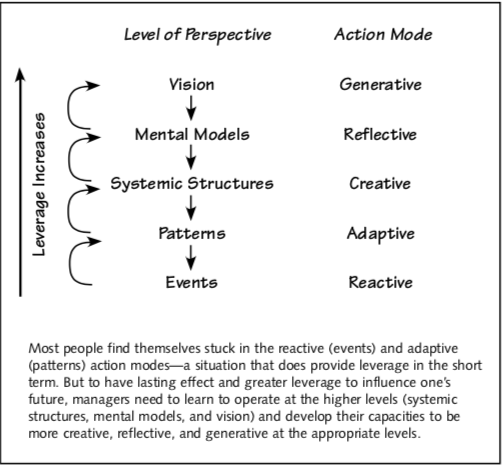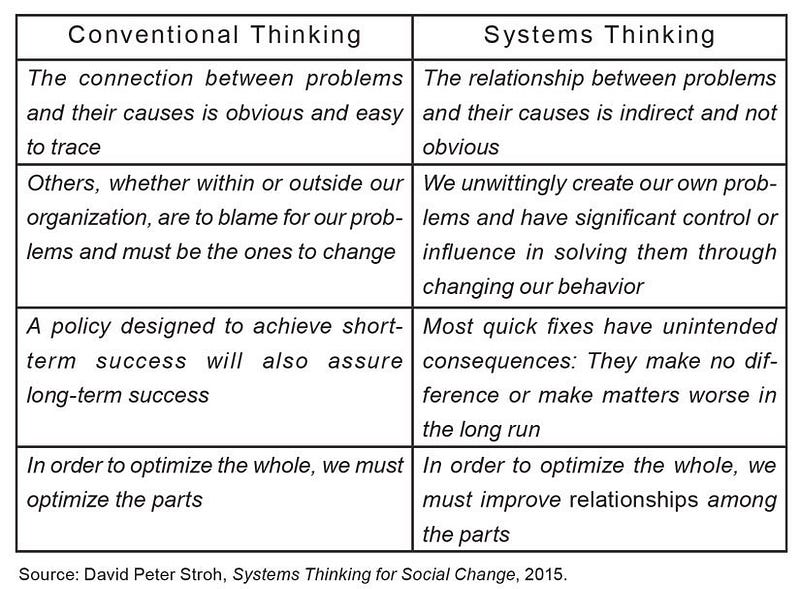LEVELS OF PERSPECTIVE
“ACTING” IN DIFFERENT MODES
Events are very compelling because they often require an instant response. For example, if a house is burning, we react by immediately trying to put out the fire. Putting out the fire is an appropriate action, but if that’s all we ever did, it would be inadequate from a systemic perspective. Why? Because it has solved the immediate problem (the burning house), but it has done nothing to alter the fundamental structures that caused that event (inadequate building codes, lack of fire detectors, lack of fire-pre- vention education, etc.). Nor has it addressed the mental models and vision that have generated the problematic systemic structures.
The “Levels of Perspective” frame- work can help us go beyond responding only to events and begin looking for actions with higher leverage (see Level of Perspective and Action Mode figure). That is, we can begin to move from working in the system to working on it.
Events — Reactive. Whenever we encounter a defective part, we sort it out and either rework it or put it in the scrap pile. We may try to correct the situation by adjusting the machinery or by inspecting more closely, but our primary mode of action is reactive. Although we tend to view reactive actions in a negative light, they can still be vital to our individual survival. However, they are not sufficient for sustaining long-term health.
Patterns — Adaptive. If we look at the problem over a period of time, we may notice a pattern, such as slower internet at certain times of the day. We can then adapt our processes to make the best use of the current system, perhaps in this case by simply accepting the fact that there’s going to be slower speed. Notice that we are not trying to change the pattern; instead, we’re simply adapting to it. We can be intentional about these adaptive actions.
Systemic Structures — Creative. Systemic structures produce the patterns and events that make up our day-to-day reality. They are also the mechanisms through which mental models and vision get translated into action (look again at the sidebar on p. 5).

By creating new systemic structures (either through redesigning existing ones or making new ones), we can change the events and patterns we get. We alter the system, rather than just adapting or reacting to it. This is the level at which many change efforts operate (reorganizations, process redesign, reengineering, compensation schemes, etc.). In our defective-parts example, we might alter the system by creating an overlap of outgoing and incoming assembly-line crews.
Mental Models — Reflective.
Altering systemic structures often requires a change in our mental images of what those structures can or ought to be. In the example we’ve been fol- lowing, if we truly believe that each assembly-line shift is responsible only for the quality of their products, then we’ll never be able to imagine a differ- ent structure, such as overlapping crews who are each responsible for more than just their own lines. Taking actions at the level of mental models is reflective, because it requires that we develop the ability to surface, suspend, and question our own assumptions about how the
world works and what’s most impor- tant. This skill also involves inviting others to do the same reflection with their mental models. (Note, though, that reflective actions do not include trying to change someone else’s mental models — that would simply be another reactive action. Changes in our own and others’ mental models come from genuine reflection and clarity of vision, not force.)
Vision — Generative. Surfacing, reflecting on, and changing our mental models is often a difficult and painful process, because those mental models are firmly embedded through years of experience. Why would we choose to put ourselves through the discomfort of changing them? Because we have a compelling vision of a new and differ- ent world that we are committed to cre- ating. At the level of vision, our actions can be generative, bringing something into being that did not exist before. For example, a vision of providing the high- est-quality products at all times through cooperation among assembly- line crews may generate the impetus to reexamine our old mental models that
say that each crew is responsible only for their own work.
Here’s another important thing to notice about the levels of perspective: Our ability to influence the future increases as we move from the level of events to that of vision. As we move up these levels, our focus shifts from the present to the future. Consequently, the actions we take at the higher levels have more impact on future outcomes, not present events.
Does this mean that high-leverage actions can be found only at the higher levels? No — because leverage is a rela- tive concept, not an absolute. For instance, if you find yourself in front of a runaway bus, that is probably not the best time to become very reflective about how you got yourself into that situation (because you won’t be reflect- ing for very long!). In this case, the high-leverage action is to react fast and get out of the way; any other action would be inappropriate. There is lever- age at every level, and the challenge lies in learning when and how to take the appropriate action for each level.
But here’s a key insight in systems thinking: How we describe our actions in the world affects the kinds of actions we take in the world. So, let’s reexamine the linear and feedback perspectives. Notice how the feedback view draws your attention to the interrelationships among all the events, whereas in the linear view, you are probably drawn to each cause-and-effect event pair. By becoming aware of all the interrelationships involved in a problem, you’re in a much better position to address the problem than if you only saw separate cause- and-effect pairs.
The main problem with the linear view is that although it may be a technically accurate way of describing what happened when, it pro- vides very little insight into how things happened and why. The primary purpose of the feedback view, on the other hand, is to gain a better understanding of all the forces that are producing the behaviors we are experiencing.

I would change the bottom right box, or add to it: “In order to optimize the whole, we must accept the sub-optimality of the parts”